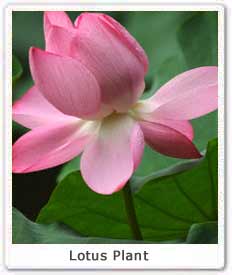| Kingdom : | Plantae |
| Division | Magnoliophyta |
| Class: | Magnoliopsida |
| Order : | Proteales |
| Family : | Nelumbonaceae |
| Genus : | Nelumbo |
| Species : | N. nucifera |
| Scientific Name : | Nelumbo nucifera |
| Found In : | Bandhavgarh National Park, Eravikulam National Park |
Other names : Ambal, Thamarai, Suriya kamal, Padma, Ambuja, Pankaja, Blue Lotus, Indian Lotus, Sacred Water lily, bean of India, Kamala, Kanwal, Kamal are the other names used for the Lotus.
Description : Lotus is the water plant. It has broad floating leaves and bright fragrant flowers. The leaves and flowers float and have long stems that contain air spaces. It has many petals overlapping in the symmetrical pattern. The root functions of the Lotus are carried out by rhizomes that fan out horizontally through the mud below the water. The round leaves are upto 50 cm in diameter. The flowers are rosy pink with little bit of white shade. The seeds are hard and dark brown in colour. They can vary in shape from round to oval to oblong. The Lotus Flower opens in the morning and the petals fall in the afternoon.

Other Species : Nymphaea caerulea is the other specie of Lotus.
Location : Lotus is found throughout India. It is widely found in the Bandhavgarh National Park, Eravikulam National Park in India.
Cultivation methods : Lotus is mostly propagated through the seeds. It is grown in the damp soil. It requires Sunlight atleast six hours a day. The Lotus plant should be fertilized regularly for one year. It is important to protect Lotus from freezing. It should be given proper light.
Medicinal uses : Lotus seeds are classified as astringent and benefits kidney, spleen, and heart. The astringent helps loss of kidney essence. The seeds are used to treat weak sexual function in men and leukorrhea in women. The seeds also helps in curing restlessness, palpitation and insomnia. Inside the seed is the green embryo the benefits the heart. The Lotus disorders are helpful in heart and liver disorders. It is prescribes as an antidote for mushroom poisoning. The leaves are used in combination with the other herbs to treat sunstroke, dysentery, fever and vomiting blood.
Other uses : The seeds of the Lotus are edible. The leaf and leaf stalk are eaten as vegetable in India. The tubers of the Lotus taste like the sweet potato. Its petals are used for garnish and the large leaves are used as the wrap for the leaves. Its seeds called Phool Mukhana are used in the Indian cooking.
Cultural Importance : Lotus is the sacred flower of India. It occupies a special position in the art and mythology of ancient India. It is also the National Flower of India. It symbolizes divinity, fertility, wealth and knowledge. In India it is considered as the symbol of triumph. As it is rooted in the mud it can survive to regerminate for thousand of years. It represents long life, honour and good fortune. For Hindus it has special significance as it used in their religious practices. It is even the sacred flower for the Buddhists in India. It is quote in puranic veds and literature many times.






